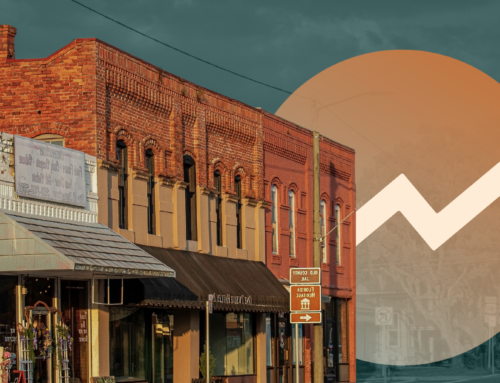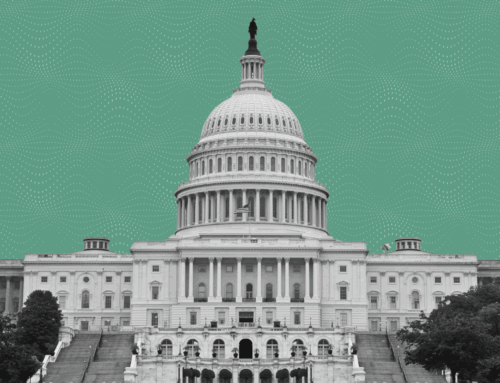Stark racial gaps persist despite incremental progress, with average Black median household income (MHI) falling as a share of white MHI in every community category since 2000.
Washington, D.C. – Today, the Economic Innovation Group (EIG) released the Distressed Communities Index (DCI), a flagship research project that maps community well-being across the country by sorting zip codes into five tiers: distressed, at risk, mid-tier, comfortable, and prosperous, offering a comprehensive look at place-based economic inequality preceding the COVID-19 crisis. The project is accompanied by a wide-ranging report entitled, “The Spaces Between Us” and an interactive map that allows users to explore all of the data included in the DCI across zip codes, counties, and congressional districts.
Using the most recent census data, the DCI shows that the U.S. failed to overcome longstanding racial, economic, geographic, and educational inequities despite periods of extended economic growth from 2000 to 2018. On measures of income, poverty, and work, the typical distressed zip code remained just as far behind the typical prosperous zip code in 2018 as at the turn of the century. These findings provide important context for policymakers as they continue to navigate an economic crisis that threatens to widen the gaps between prosperous and distressed areas.
“This research is a sobering reminder that the United States has largely failed to translate national economic growth into tangible improvements for our country’s most vulnerable communities since the turn of the century,” said EIG President and CEO John Lettieri. “In the midst of the pandemic and economic crisis, policymakers move with greater urgency to lay the groundwork for a broad-based recovery — one that truly reaches the 50 million Americans living in distressed communities.”
While some groups and regions experienced progress since the turn of the century, overall there has been little convergence in levels of economic well-being nationwide. The research also finds that the geography of well-being has shifted as cities advance relative to rural areas and the West gains relative to the Midwest and New England. These gaps in community well-being are sustained by distinctive disparities in growth and education.
“These findings showcase just how many aspects of our lives still break along lines of race and place” said EIG Research Director Kenan Fikri. “While abstract forces such as a pandemic should be colorblind, pre-existing inequalities render this impossible. Prosperous places and the households in them enjoy an intrinsic resiliency that eludes much of the rest of the country.”
Key findings and themes from the report include:
So far in the 21st century, national economic growth has failed to lift the country’s most vulnerable communities.
- On measures of income, poverty, joblessness, and vacancy, the typical distressed zip code remained just as far behind the typical prosperous zip code in 2018 as it was in 2000.
- At 50.5 million, the number of Americans living in distressed communities held constant even as the country’s population grew significantly.
- A plurality of Americans (82.4 million) call prosperous zip codes home, but population increased fastest in the mid-tier category.
- Zip codes that were prosperous in 2000 gained 8.7 million jobs between 2000 and 2018, generating nearly 62 percent of total U.S. job growth over the period.
- Meanwhile, zip codes that were distressed at the turn of the century lost jobs on net between 2000 and 2018. Numbers of jobs and businesses in distressed communities even fell from 2014 to 2018, deep into the national recovery from the Great Recession.
- Community-level advantages and disadvantages tend to perpetuate over time. Two-thirds of zip codes that ranked as prosperous in 2000 were prosperous in 2018. Likewise, two-thirds of zip codes that were distressed at the turn of the century remained so.
The geography of well-being has shifted as cities and the West gain ground.
- The total population of prosperous urban zip codes doubled from 2000 to 2018 and the country’s urban geography expanded, especially in the West. These advances were uneven, however, as the number of prosperous zip codes flatlined or declined across 61 of the country’s 100 largest cities.
- The share of the country’s urban population residing in distressed zip codes fell from 34.3 percent to 21.7 percent over the period—still slightly edging out the other quintiles. Meanwhile the share of rural Americans living in distressed zip codes rose to 23.6 percent.
- In the West, 53.4 percent of the population resides in a prosperous or comfortable zip code, a greater share than in any other region. It displaced the Midwest, which led in American economic well-being in 2000 but now trails even the Northeast.
In spite of significant progress, Americans’ exposure to community prosperity and distress remains profoundly divided along racial lines.
- The minority share of the population in prosperous zip codes jumped from 16.3 percent to 26.9 percent between 2000 and 2018 and declined slightly in the distressed quintile to 56.4 percent, still leaving communities of color significantly overrepresented at the bottom.
- The share of the country’s Black population living in distressed zip codes declined from 45.6 percent in 2000 to 35.3 percent in 2018. But in the Midwest, fully half of the Black population still lives in distressed communities.
- Racial inequality is observed at every level of community well-being, but especially in distressed areas, where the median income (MHI) for the typical Black household was only 66 percent that of the typical white household. Across every quintile, the typical Black MHI fell as a share of white MHI between 2000 and 2018.
- An overwhelming 70 percent of majority-Black zip codes are distressed, compared to 20 percent of zip codes nationally and 16 percent of majority-white zip codes. Only 19 majority-Black zip codes rank as prosperous on the DCI.
About the DCI
This is the fourth edition of the DCI, which was first launched in 2015. The DCI is calculated at four different levels of geography, each scale revealing its own insights about the U.S. economy: zip codes, counties, cities, and congressional districts. The centerpiece of the DCI is an interactive map that allows users to explore data at the zip code, county, and congressional district levels by state. The DCI is derived from the U.S. Census Bureau’s Business Patterns and American Community Survey 5-Year Estimates for the 2014-2018 period. It covers nearly 25,500 zip codes and 99 percent of the U.S. population.
EIG media contact: Cal Harris ([email protected])
About the Economic Innovation Group (EIG)
The Economic Innovation Group (EIG) is an ideas laboratory and advocacy organization whose mission is to advance solutions that empower entrepreneurs and investors to forge a more dynamic American economy. Headquartered in Washington, D.C. and led by an experienced, bipartisan team, EIG convenes leading experts from the public and private sectors, develops original policy research, and works to advance creative legislative proposals that will bring new jobs, investment, and economic growth to communities across the nation. For more information, visit eig.org.
###






